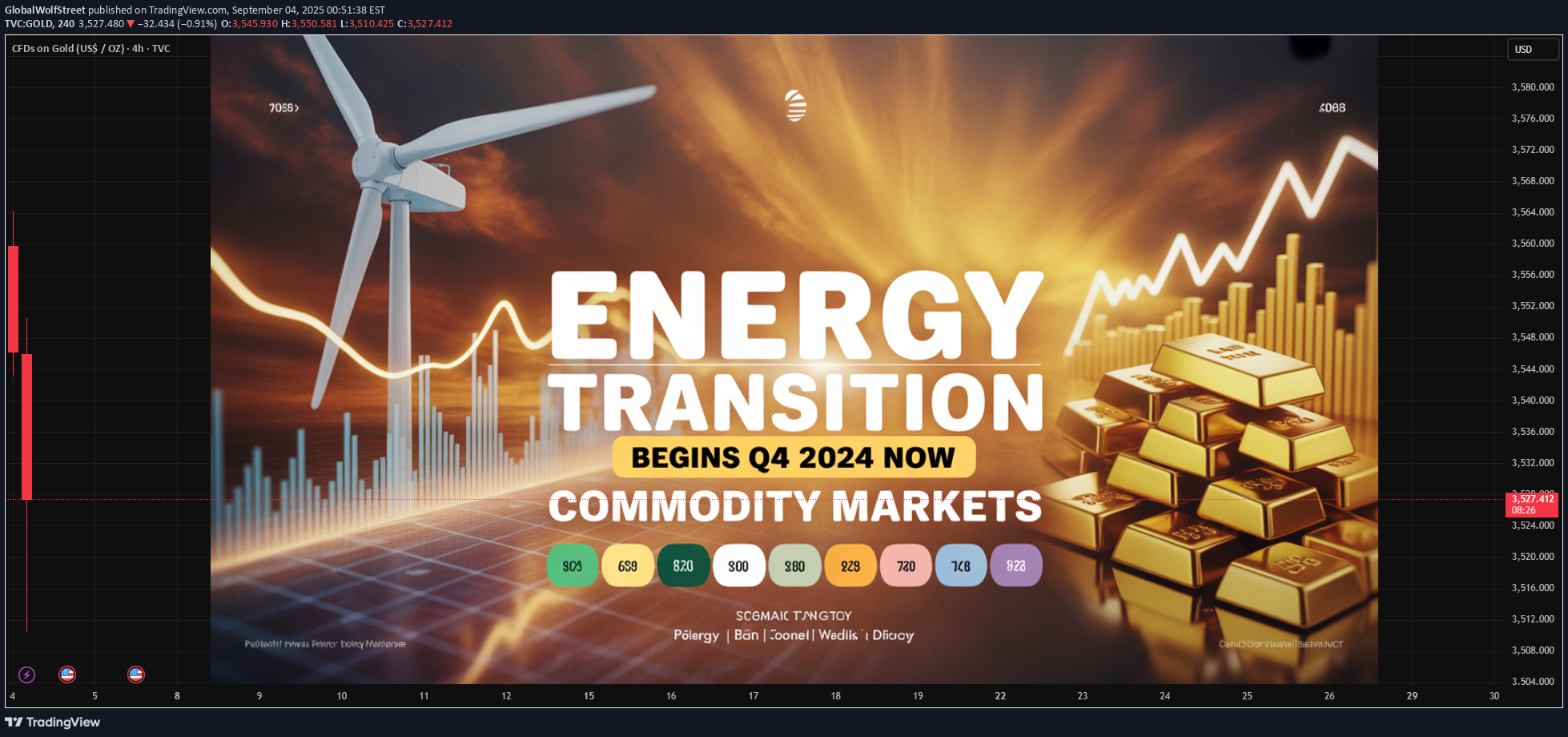تحلیل تکنیکال GlobalWolfStreet درباره نماد PAXG در تاریخ ۱۴۰۴/۶/۱۳

Section 1: Understanding the Energy Transition 1.1 Definition Energy transition is the process of moving from an energy system dominated by fossil fuels to one that relies on low-carbon and renewable energy sources. Unlike past energy transitions (from wood to coal in the Industrial Revolution, or from coal to oil in the 20th century), today’s transition is policy-driven and environmentally motivated, with the goal of achieving net zero carbon emissions by mid-century. 1.2 Drivers of Energy Transition Climate Change Mitigation: To limit global warming to 1.5–2°C, greenhouse gas emissions must be drastically reduced. Technological Innovation: Falling costs of solar, wind, batteries, and green hydrogen are accelerating adoption. Energy Security: Dependence on imported fossil fuels creates vulnerabilities; renewables offer greater resilience. Investor & Consumer Demand: ESG (Environmental, Social, and Governance) investing and rising public awareness are pushing corporations to decarbonize. 1.3 Key Pillars Electrification of transport and industry Renewable energy deployment Energy efficiency improvements Carbon capture and storage (CCS) Hydrogen economy development Section 2: Commodity Markets – An Overview Commodity markets are broadly divided into: Energy Commodities – oil, natural gas, coal. Metals & Minerals – iron ore, copper, aluminum, lithium, cobalt, nickel, rare earths. Agricultural Commodities – grains, oilseeds, sugar, biofuels (ethanol, biodiesel). Commodity markets are crucial because they: Provide raw materials for energy systems. Influence inflation, currency stability, and trade balances. Reflect global supply-demand dynamics and geopolitical risks. As energy transition reshapes global energy flows, commodity markets are entering a new cycle of volatility, opportunities, and risks. Section 3: Fossil Fuels in Transition 3.1 Oil Oil has been the dominant energy commodity for decades, but demand growth is slowing. Short-term Outlook: Oil remains essential for transportation, petrochemicals, and aviation. Long-term Outlook: EV adoption, efficiency improvements, and policies to phase out ICE (internal combustion engine) vehicles could lead to peak oil demand by 2030–2040. Impact: Oil-exporting countries may face revenue shocks, while diversification becomes urgent. 3.2 Natural Gas Often seen as a “bridge fuel”, natural gas emits less CO₂ than coal and oil. Role in Transition: Supports grid stability as renewables expand; key in hydrogen production (blue hydrogen). Risks: Methane leakage undermines its climate benefits; long-term role uncertain. 3.3 Coal Coal is the biggest loser in the energy transition. Decline: Many advanced economies are phasing out coal due to high carbon intensity. Exceptions: Some Asian countries still rely on coal for cheap electricity. Impact: Coal markets are shrinking; future limited to metallurgical coal for steelmaking. Section 4: Green Metals and Minerals The clean energy revolution is metal-intensive. According to the International Energy Agency (IEA), a typical EV requires 6 times more minerals than a conventional car, while a wind farm needs 9 times more mineral resources than a gas-fired plant. 4.1 Copper Used in wiring, EV motors, and renewable energy grids. Copper demand expected to double by 2040. 4.2 Lithium Key for lithium-ion batteries in EVs and storage. Demand projected to increase over 40 times by 2040. 4.3 Cobalt Critical in high-density batteries. Supply concentrated in the Democratic Republic of Congo (DRC), raising geopolitical and ethical concerns. 4.4 Nickel Important for battery cathodes. Growing demand in EV sector; Indonesia emerging as a dominant supplier. 4.5 Rare Earth Elements (REEs) Essential for wind turbines, EV motors, and defense technologies. Supply dominated by China, creating potential geopolitical risks. Section 5: Renewable Energy & Commodity Linkages 5.1 Solar Power Relies heavily on silicon, silver, aluminum, and glass. Commodity markets for silver are increasingly influenced by solar demand. 5.2 Wind Energy Requires large amounts of steel, copper, and rare earths. Offshore wind is even more metal-intensive than onshore. 5.3 Hydrogen Economy Green hydrogen needs renewable electricity and electrolyzers (requiring platinum, iridium). Blue hydrogen depends on natural gas and carbon capture. 5.4 Energy Storage Batteries are the backbone of renewables integration. Metals like lithium, cobalt, nickel, and graphite see exponential demand. Section 6: Geopolitical and Economic Dimensions 6.1 Resource Nationalism As green commodities rise in importance, countries rich in lithium, cobalt, and rare earths may adopt resource nationalism policies, similar to OPEC’s oil strategies. 6.2 Supply Chain Vulnerabilities Concentration of rare earth supply in China. Lithium reserves in South America’s “Lithium Triangle” (Argentina, Bolivia, Chile). Cobalt dominated by DRC, raising human rights concerns. 6.3 Trade Wars & Strategic Competition U.S. and Europe are investing in domestic critical mineral supply chains to reduce dependency. Strategic competition may reshape global trade patterns. Section 7: Financial Markets and Investment Trends 7.1 ESG Investing Investors are shifting capital towards green energy and sustainable commodities. Oil and coal financing becoming harder to secure. 7.2 Carbon Markets Carbon pricing and emissions trading systems (ETS) affect fossil fuel demand. Commodities linked to higher carbon footprints face declining attractiveness. 7.3 Commodity Price Volatility Green transition is creating supercycles in certain metals. Shortages may push prices higher, while substitution and recycling could stabilize markets. Section 8: Challenges in the Energy Transition 8.1 Supply Constraints Mining and refining capacity may lag demand. Long lead times (10–15 years) for new mines. 8.2 Environmental & Social Risks Mining expansion may harm ecosystems and local communities. Human rights abuses in supply chains (child labor in cobalt mining). 8.3 Technology Uncertainty Battery chemistry may shift, reducing reliance on certain metals. Hydrogen adoption uncertain due to costs and infrastructure needs. 8.4 Policy Uncertainty Inconsistent climate policies create market volatility. Subsidy cuts or political shifts can slow adoption. Section 9: Opportunities in the Transition 9.1 Green Commodity Supercycle Metals like lithium, copper, and nickel could see decades of sustained demand growth. 9.2 Recycling and Circular Economy Battery recycling could reduce dependence on virgin mining. “Urban mining” of e-waste emerging as a new industry. 9.3 Technological Innovation Advances in battery tech (solid-state batteries). Substitutes for scarce materials (cobalt-free batteries). 9.4 Emerging Markets Growth Developing countries rich in green resources may benefit from foreign investment. Section 10: Future Outlook The energy transition will not be linear; it will involve disruptions, volatility, and regional variations. However, the direction is clear: Fossil fuels will gradually decline. Metals and minerals critical to clean energy will dominate commodity markets. Policies and geopolitics will heavily influence market outcomes. By 2050, the global energy system could look dramatically different—one where electricity is the main energy vector, renewables provide the majority of supply, and commodity markets revolve around green resources rather than hydrocarbons. Conclusion The energy transition is reshaping the foundations of the global commodity markets. While fossil fuels are gradually losing ground, metals and minerals essential to renewable technologies are entering a period of unprecedented demand growth. This shift brings both challenges—such as supply constraints, geopolitical risks, and environmental concerns—and opportunities, including green investment booms, technological innovation, and sustainable growth. Ultimately, the interplay between energy transition and commodity markets will define the economic and geopolitical landscape of the 21st century. Countries, companies, and investors that adapt swiftly will be the leaders of the new energy age, while those clinging to the old fossil-fuel paradigm risk being left behind.
